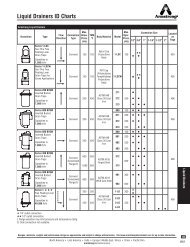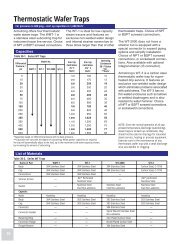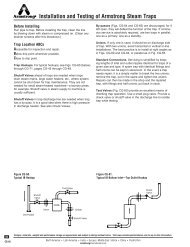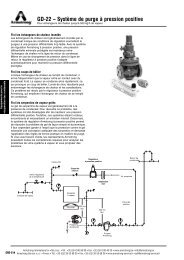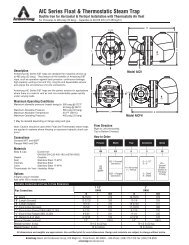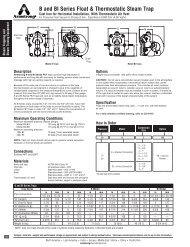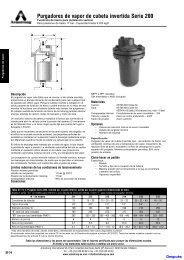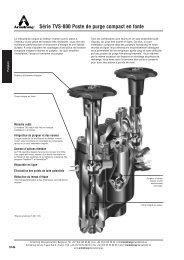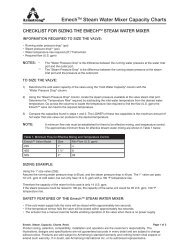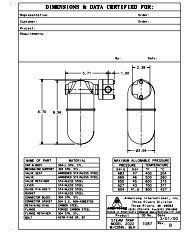How to Trap Steam Distribution Systems - Armstrong International, Inc.
How to Trap Steam Distribution Systems - Armstrong International, Inc.
How to Trap Steam Distribution Systems - Armstrong International, Inc.
You also want an ePaper? Increase the reach of your titles
YUMPU automatically turns print PDFs into web optimized ePapers that Google loves.
<strong>How</strong> <strong>to</strong> <strong>Trap</strong> Space Heating EquipmentSpace heating equipment such as unit heaters, air handlingunits, finned radiation and pipe coils is found in virtually allindustries. This type of equipment is quite basic and shouldrequire very little routine maintenance. Consequently, thesteam traps are usually neglected for long periods of time.One of the problems resulting from such neglect is residualcondensate in the heating coil, which can cause damagedue <strong>to</strong> freezing, corrosion and water hammer.<strong>Trap</strong> Selection and Safety Fac<strong>to</strong>rsDifferent application requirements involving constant orvariable steam pressure determine which type and size oftrap should be used. There are two standard methods forsizing traps for coils.1. Constant <strong>Steam</strong> Pressure.INVERTED BUCKET TRAPS AND F&T TRAPS—Use a3:1 safety fac<strong>to</strong>r at operating pressure differentials.2. Modulating <strong>Steam</strong> Pressure.F&T TRAPS AND INVERTED BUCKET TRAPSWITH THERMIC BUCKETS■ 0-15 psig steam—2:1 safety fac<strong>to</strong>r at 1/2 psi pressuredifferential■ 16-30 psig steam—2:1 at 2 psi pressure differential■ Above 30 psig steam—3:1 at 1/2 of maximum pressuredifferential across the trap.INVERTED BUCKET TRAPS WITHOUT THERMIC BUCKETSAbove 30 psig steam pressure only—3:1 at 1/2 of maximumpressure differential across the trap.<strong>Trap</strong> Selection for Unit Heatersand Air Handling UnitsYou may use three methods <strong>to</strong> compute the amount ofcondensate <strong>to</strong> be handled. Known operating conditionswill determine which method <strong>to</strong> use.1. Btu method. The standard rating for unit heaters andother air coils is Btu output with 2 psig steam pressure inthe heater and entering air temperature of 60°F. To convertfrom standard <strong>to</strong> actual rating, use the conversion fac<strong>to</strong>rsin Table CG-16 (page CG-27). Once the actual operatingconditions are known, multiply the condensate load bythe proper safety fac<strong>to</strong>r.2. CFM and air temperature rise method. If you knowonly CFM capacity of fan and air temperature rise,find the actual Btu output by using this simple formula:Btu/hr = CFM x 1.08 x temperature rise in °F.EXAMPLE: What size trap will drain a 3,500 CFM heaterthat produces an 80°F temperature rise? <strong>Steam</strong> pressureis constant at 60 psig.Using the formula:3,500 x 1.08 x 80 = 302,400 Btu/hr.Now divide 302,400 Btu/hr by 904.5 Btu (from the <strong>Steam</strong>Tables) <strong>to</strong> obtain 334 lbs/hr and then multiply by the recommendedsafety fac<strong>to</strong>r 3. The application needs a trap with a1,002 lbs/hr capacity.Derive the 1.08 fac<strong>to</strong>r in the above formula as follows:1 CFM x 60 = 60 CFH60 CFH x .075 lbs of air/cu ft = 4.5 lbs of air/hr4.5 x 0.24 Btu/lb -°F (specific heat of air) = 1.08 Btu/hr °F - CFM.3. Condensate method.Once you determine Btu output:a. Divide Btu output by latent heat of steam at steampressure used. See Column 2 of Table CG-16(page CG-27) or the <strong>Steam</strong> Table (page CG-3). This willgive the actual weight of steam condensed. For a closeapproximation, a rule of thumb could be applied inwhich the Btu output is simply divided by 1,000.b. Multiply the actual weight of steam condensing bythe safety fac<strong>to</strong>r <strong>to</strong> get the continuous trap dischargecapacity required.Chart CG-11. Multipliers for Sizing <strong>Trap</strong>s for Multiple CoilsMULTIPLIER20171512108765STEAM PRESSURE PSIG2 5 10 15 25 50 100 125 180 250 201715FORCED AIR CIRCULATIONDRYING WET CLAYDAMP ATMOSPHERESORDINARY SPACE HEATING442 5 10 15 25 50 100 125 180 25012108765MULTIPLIER30CG-25Chart CG-12. Recommendation Chart(See Page CG-2 for “Feature Code” References.)Equipment Being<strong>Trap</strong>pedUnit HeatersAir Handling UnitsFinned Radiation &Pipe Coils1st Choice andConstant Pressure1st Choice andVariable PressureFeature Code 0-30 psig Above 30 psig Feature Code 0-30 psig Above 30 psigB, C, E, K, N IBLV IBLV B, C, G, H, L F&T *F&TAlternate Choice F&T *F&T Alternate Choice IBLV IBLVB, C, E, K, N, O IBLV IBLV B, C, G, H, L F&T *F&TAlternate Choice F&T *F&T Alternate Choice IBT IBLVB, C, E, K, N IBLV IBLV B, C, G, H, L F&T F&TAlternate Choice Thermostatic Thermostatic Alternate Choice IBLV IBLV*Use IBLV above F&T pressure/temperature limitations.PLEASE NOTE: 1. Provide vacuum breaker wherever subatmospheric pressures occur.2. Do not use F&T traps on superheated steam.<strong>Armstrong</strong> <strong>Steam</strong> and Condensate Group, 816 Maple St., P.O. Box 408, Three Rivers, MI 49093 – USA Phone: (269) 273-1415 Fax: (269) 278-6555www.armstrong-intl.com



